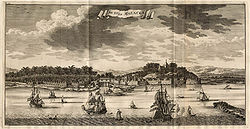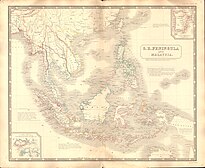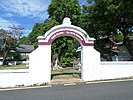Governorate of Malacca | |||||||||
|---|---|---|---|---|---|---|---|---|---|
| 1641–1795 1818–1825 | |||||||||
 Malacca between 1750 and 1796 | |||||||||
 Dutch Malacca, ca. 1724–26 | |||||||||
| Status | Colony of the Dutch East India Company (1641–1795) Part of the Dutch East Indies (1818–1825) | ||||||||
| Capital | Malacca Town | ||||||||
| Common languages | Dutch, Malay | ||||||||
| Governor | |||||||||
• 1641–42 | Jan van Twist | ||||||||
• 1824–25 | Hendrik S. van Son | ||||||||
| British Resident | |||||||||
• 1795 | Archibald Brown | ||||||||
• 1803–18 | William Farquhar | ||||||||
| Historical era | Imperialism | ||||||||
• Established | 14 January 1641 | ||||||||
• British occupation | 1795–1818 | ||||||||
| 1 March 1825 | |||||||||
| |||||||||
| Governorate of Malacca Gouvernement Malacca | |||||||
|---|---|---|---|---|---|---|---|
| Governorates of Dutch East Indies | |||||||
| 1818–1825 | |||||||
 Map of the governorate of Malacca. | |||||||
| Capital | Malacca Town | ||||||
| History | |||||||
• Established | 1818 | ||||||
| 1 March 1825 | |||||||
| |||||||
| Today part of | Malacca, Malaysia | ||||||
Dutch Malacca (1641–1825) was the longest period that Malacca was under foreign control. The Dutch ruled for almost 183 years with intermittent British occupation during the Napoleonic Wars (1795–1815). This era saw relative peace with little serious interruption from the Malay sultanates due to the understanding forged between the Dutch and the Sultanate of Johor in 1606. This time also marked the decline of the importance of Malacca. The Dutch preferred Batavia (present-day Jakarta) as their economic and administrative centre in the region and their hold in Malacca was to prevent the loss of the city to other European powers and, subsequently, the competition that would come with it. Thus, in the 17th century, with Malacca ceasing to be an important port, the Johor Sultanate became the dominant local power in the region due to the opening of its ports and the alliance with the Dutch.









